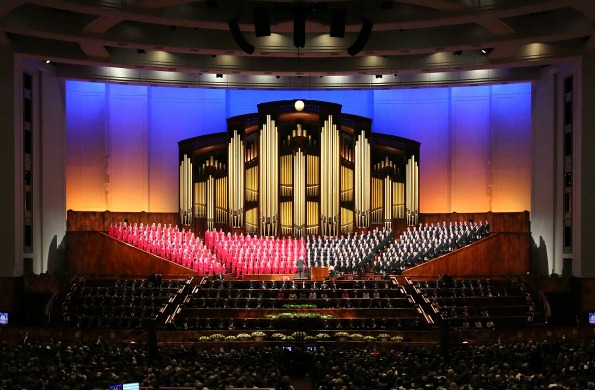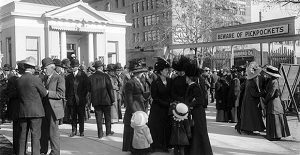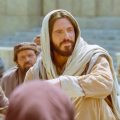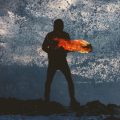The 189th General Conference for The Church of Jesus Christ of Latter-day Saints is just around the corner—April 6-7, 2019. Twice every year, members of the Church gather together as a worldwide family to celebrate as Church leaders share inspired counsel and revelation. It is also a great opportunity to get together as families, friends, and new acquaintances, to eat, laugh, and learn. Many family groups have created traditions surrounding the spring and fall conference that range from green jello salad to apostle bingo.
We know that the early Saints of this dispensation participated in a semi-annual conference, so this event has taken place for just about 200 years. These Saints even held a conference meeting aboard the Big Blue River ferryboat on the Missouri river in 1833. How often, however, do we pause to reflect on the examples of General Conference throughout the scriptures?
How far back does this tradition really go?
Are there patterns that can help us better understand our modern general conference experience?
Let’s take a look.
General Conference of Biblical Proportions
One of the earliest traditions of a spiritual gathering in great numbers comes to us from the Old Testament in the book of Exodus. As the Israelites crisscrossed the wilderness in search of the Promised Land, they were instructed to build a tabernacle—a portable temple. Given explicit instructions, the Israelites carried out the construction to perfection.
It was to be knows as a place of sanctuary, or “a place of meeting,” (Numbers 2:2), and that each man should “pitch his tent by his own standard, with the ensign of their father’s house…,” (Numbers 2:2) towards the tabernacle. They were instructed to approach the place of meeting in order to inquire of the Lord. On behalf of the group, Moses would enter into the tabernacle and commune with God, receiving revelation directly from the source. Afterwards, Moses would return and share God’s will with his people.
In this manner, the tabernacle acted as a meeting place for the Israelites to receive revelation. It was also a meeting place of heaven and earth. We know that the Spirit of God cannot dwell in unclean places, and the tabernacle was specifically set aside to provide a place of divine potential for this purpose.
Tell Me the Stories of Jesus
 Jesus Himself was known to hold a general meeting or two when He walked the dusty roads during His earthly mission. Often these gatherings take place in an area removed from public life that his followers would have to travel to in order to gain His presence. We find Jesus teaching to multitudes in the desert, on a boat, and in the mountains. These private places take on the same symbolic nature as that of the tabernacle—a sacred space set apart where heaven and earth can be closely united—a sacred space that one must work to find.
Jesus Himself was known to hold a general meeting or two when He walked the dusty roads during His earthly mission. Often these gatherings take place in an area removed from public life that his followers would have to travel to in order to gain His presence. We find Jesus teaching to multitudes in the desert, on a boat, and in the mountains. These private places take on the same symbolic nature as that of the tabernacle—a sacred space set apart where heaven and earth can be closely united—a sacred space that one must work to find.
In two such cases, we find that the gathered throng has been so intent on hearing the words of Christ that they have forgotten to eat. It is true that Christ’s disciples doubt His ability to feed the multitudes with a few loaves of bread and a meager fish or two, but it has always been Christ’s way to work in miracles. And so He does—providing enough food that there is enough and to spare.
Book of Mormon Stories
The Book of Mormon is also replete with opportunities to see general conference in action.
Lehi
On his death bed, Father Lehi gathers his family—the seeds of a remarkable new nation—around him to share what amounts to a conference talk about the plan of salvation, free agency, and the need for opposition in all things. He takes special care to speak to the families of each of his children, both sons and daughters, and share with them a final blessing:
“But behold, my sons and my daughters, I cannot go down to my grave save I should leave a blessing upon you; for behold, I know that if ye are brought up in the way ye should go ye will not depart from it…
“Wherefore, because of my blessing the Lord God will not suffer that ye shall parish; wherefore, he will be merciful unto you and unto your seed forever” (2 Nephi 4: 5,7).
Jacob
Not many years later, Jacob, having assumed the role of prophet from his brother Nephi, climbs the steps of the temple “to declare unto [his people] the word of God” (Jacob 2:2). We know that this general conference also included families, as Jacob tells us so with his own words:
“…I must use boldness of speech concerning you, before your wives and your children…they have come up hither to hear the pleasing word of God…the word which healeth the wounded soul.” (Jacob 2: 2, 7, 8)
In this particular case, the message that Jacob had originally prepared to share with his family and friends was put aside in favor of more timely revelation delivered by the Lord. This reflects our modern belief in continuous revelation, as well as the strong emotions a prophet feels for his flock:
“…this day [I] am weighed down with much more desire and anxiety for the welfare of your souls than I have hitherto been,” (Jacob 2:3).
He also tells us that it is his responsibility to share the words that the Lord wishes for his people to hear, no matter the cost of sharing that message:
“…my beloved brethren…according to the responsibility which I am under to god, to magnify mine office with soberness, and that I might rid my garments of your sins, I come up into the temple this day that I might declare unto you the word of God” (Jacob 2: 1).
King Benjamin
 We might also recall, as diligent scriptorians, the general conference hosted by King Benjamin at the end of his life when he caused a tower to be erected on the grounds of the temple and invited each of his subjects to “pitch their tents round about, every man according to his family…having his tent with the door…towards the temple” (Mosiah 2:5-6).
We might also recall, as diligent scriptorians, the general conference hosted by King Benjamin at the end of his life when he caused a tower to be erected on the grounds of the temple and invited each of his subjects to “pitch their tents round about, every man according to his family…having his tent with the door…towards the temple” (Mosiah 2:5-6).
On this occasion, the saints came not only to listen to the pleasing word of God, but also to give thanks for their many blessings, one of whom is King Benjamin himself. I love that these saints recognize the benefit of a good leader—a man “who had taught them to keep the commandments of God, that they might rejoice and be filled with love towards God and all men” (Mosiah 2:4).
Jesus Christ
For all of the examples of religious gatherings in the Book of Mormon, perhaps the most significant general conference we can read about is the one in which Jesus Christ Himself presided. It was a general conference much looked forward to, as Christ Himself tells the assembled throng:
“…I am Jesus Christ, whom the prophets testified shall come into the world.” (3 Nephi 11: 10)
And in perhaps one of the shortest conference talks ever given, Christ pretty much lays out the entire gospel complete with visual aids:
“…I am the light and the life of the world; and I have drunk out of that bitter cup which the Father hath given me, and have glorified the Father in taking upon me the sins of the world, it the which I have suffered the will of the Father in all things…
“Arise and come forth unto me, that ye may thrust your hands into my side, and also that ye may feel the prints of the nails in my hands and in my feet, that ye may know that I am the God of Israel, and the god of the whole earth, and have been slain for the sins of the world.” (3 Nephi 11:11,14)
This was certainly a historical occasion, not only because it was so looked forward to from the beginning of time, but because it was a powerful enough event to last in the hearts and minds of a group of saints for almost four hundred years. It changed their social and political views in such a way that differences no longer mattered, and the sharing of wealth and abundance was done by common consent.
Ancient Patterns for a Modern View
In the examples of these few ancient prophets, we have uncovered at least eight patterns that can provide a deeper meaning for our modern general conference experience:
- A general meeting held in a sacred, set apart location
- A source of spiritual revelation specific to time, period, or situation
- An opportunity for families to learn and receive revelation together
- Prophets invest great care and emotion into each message they share
- Profound gospel truths are shared
- It is an opportunity to listen for divine prophecy that can impact our future
- An opportunity to have our hearts and minds changed forever
- Guidance for navigating the turbulent socio-political landscape
In the End…
 Certainly, dear reader, there are many more examples of general conferences within the pages of the scriptures. I have only chosen to highlight a few that I have grown familiar with as I have searched the scriptures myself. But what I have come away with is an increased reverence for the privilege that we as members of The Church of Jesus Christ of Latter-day Saints have been given to participate in this ancient tradition. As these eight patterns show, these events are of a sacred nature and provide another opportunity for heaven and earth to touch for two brief days.
Certainly, dear reader, there are many more examples of general conferences within the pages of the scriptures. I have only chosen to highlight a few that I have grown familiar with as I have searched the scriptures myself. But what I have come away with is an increased reverence for the privilege that we as members of The Church of Jesus Christ of Latter-day Saints have been given to participate in this ancient tradition. As these eight patterns show, these events are of a sacred nature and provide another opportunity for heaven and earth to touch for two brief days.
As you listen to the speakers, think about Moses, Lehi, or Jacob as they wrestled within themselves to receive revelation and share the exact message Christ intended for His people to hear. You can be sure that each speaker that will share a message this weekend has endured a similar struggle.
As you listen to the speakers, take a moment to look around at your companions—whether it is a group of friends, your near and dear family, or just by yourself—and recognize that this is exactly how Christ has intended for us to receive revelation, surrounded by those who you feel an increase of love towards.
And finally, recognize that you are taking part in a sacred tradition that has endured from the beginning of religious tradition. Perhaps even before that (think our premortal life). What a welcome opportunity we have to participate in something so sacred and lasting, and to find new and unique ways to make it entirely our own.
About Jessica Clark
Jessica Clark is a wife, mom, writer, runner, knitter, and proud Canadian. She graduated from Brigham Young University with a degree in Anthropology, and has been a student of people and cultures ever since. Right now she is busy studying the behavior and cultures of the people of Texas.
Twitter •







